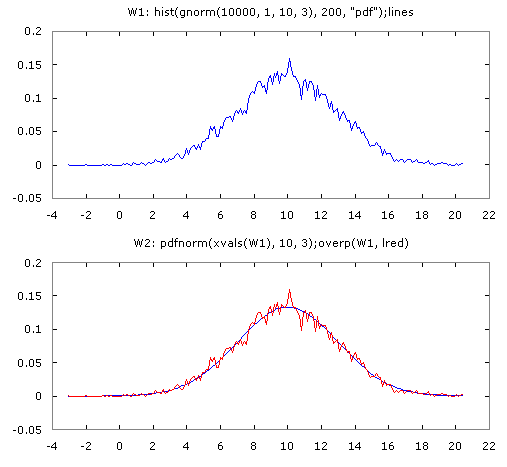
DADiSP Online Help
Click here to see this page in full context

Returns the probability density function for a normal distribution.
PDFNORM(z, mean, std)
|
z |
- |
A real or series. The z value. |
|
mean |
- |
Optional. A real, the mean of the distribution. Defaults to 0.0. |
|
std |
- |
Optional. A real, the standard deviation of the distribution, where |
A real or series, the value of the normal distribution function for the given mean and standard deviation.
pdfnorm(0)
returns 1, the value of the normal distribution with a mean of 0.0 and a standard deviation of 1.0.
pdfnorm(-8..0.01..8)
displays the normal distribution with a mean of 0.0 and a standard deviation
of 1.0 over the range -8 to 8.
pdfnorm(-8..0.01..8, 0, 2.0)
Same as above except the standard deviation of the distribution is set to 2.0.
W1: hist(gnorm(10000, 1, 10, 3), 200, "pdf");lines
W2: pdfnorm(xvals(W1), 10, 3);overp(W1, lred)

Compares the calculated normal distribution of random values with mean 10 and standard deviation 3 in W1 with the analytic distribution in W2. The overplotted histogram is normalized to provide an visual accurate comparison.
The result is NaN where std
The probability density function, f(x), for normally distributed random values is:

where μ is the mean, σ is the standard deviation and σ2 is the variance. The cumulative distribution function,

where erf(x) is the error function implemented by ERF.
Approximately 68% of the values from a normal distribution are within one standard deviation away from the mean. Approximately 95% of the values lie within two standard deviations and approximately 99.7% are within three standard deviations. This is known as the 3-sigma rule.
See PROBN to calculate the normal cumulative distribution function.
See GNORMAL to generate a series of normally distributed random values.